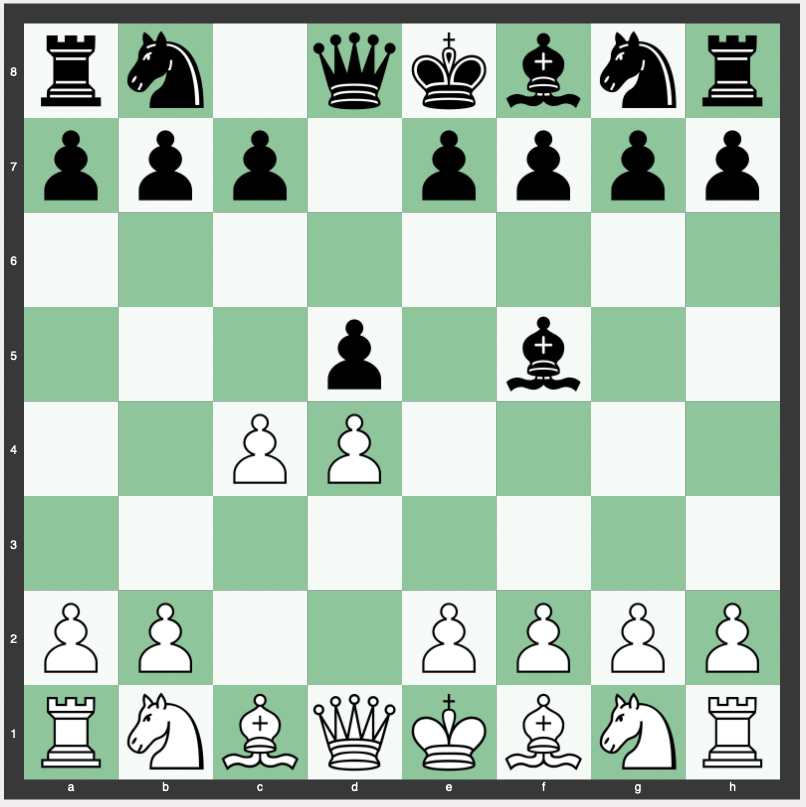The Baltic Defense is a unique and intriguing opening that begins with the moves 1.d4 d5 2.c4 Bf5.
It’s a response to the Queen’s Gambit that stands out for its originality and tactical richness.
Here we look into the details of the Baltic Defense, covering the move order, theory, strategy, variations, history, and its suitability for different levels of players. We’ll also examine how often this defense is played at the grandmaster level.
Move Order of the Baltic Defense
The Baltic Defense is reached after the moves 1.d4 d5 2.c4 Bf5.
1.d4: White opens the game with a central pawn advance.
1…d5: Black responds with a symmetrical pawn advance in the center.
2.c4: White initiates the Queen’s Gambit, attacking the central d5 pawn.
2…Bf5: Black’s response is the Baltic Defense, developing the bishop to f5 rather than defending the pawn on d5 with a traditional move like 2…e6 or accepting the Queen’s Gambit.

Theory, Strategy, and Purpose of the Baltic Defense
The Baltic Defense is characterized by a quick bishop development and an unorthodox approach to the Queen’s Gambit.
The strategy is to put pressure on the center and make it difficult for White to easily build a strong pawn center.
The purpose of 2…Bf5 is to allow Black to maintain flexibility and create potential tactical opportunities in the opening phase.
Variations of the Baltic Defense
There are several variations within the Baltic Defense, including:
- The 3.cxd5 Bxb1 variation, capturing the pawn and trading bishops.
- The 3.Nc3 e6 line, continuing to develop pieces while maintaining central tension.
- The rarer 3.Qb3, attacking both the b7 and (potentially) d5 pawns.
Evaluation of the Baltic Defense
The evaluation of the Baltic Defense is +1.00 to +1.20.
Sample Continuation Lines of the Baltic Defense
Continuation lines of the Baltic Defense include:
3. cxd5 Bxb1 4. Rxb1 Qxd5 5. Nf3 e6 6. Bd2 Nf6 7. e3 Nbd7 8. Rc1 Bd6 9. Bc4 Qh5 10. h3 O-O 11. O-O c5 12. Bc3 Ne4 13. Be2
3. cxd5 Bxb1 4. Rxb1 Qxd5 5. e3 Nf6 6. Nf3 e6 7. b4 a5 8. bxa5 Qxa5+ 9. Bd2 Qxa2 10. Bd3 Qa7 11. Qc2 c6
3. cxd5 Bxb1 4. Rxb1 Qxd5 5. e3 e6 6. b4 Nf6 7. Nf3 Qxa2 8. Bd3 a5 9. bxa5 Qxa5+ 10. Bd2 Qa7 11. Qc2 c6 12. O-O h6 13. e4 Be7 14. d5 exd5 15. e5 Ne4 16. Bxe4
3. cxd5 Bxb1 4. Rxb1 Qxd5 5. e3 e6 6. Bd2 Nf6 7. Nf3 Qxa2 8. Rc1 Nc6 9. Bb5 Bd6 10. Rxc6 bxc6 11. Bxc6+ Ke7 12. e4 Rab8 13. e5 Nd5 14. exd6+ cxd6 15. Bxd5 Qxd5
History of the Baltic Defense
The Baltic Defense has its origins in the early 20th century.
It has been employed by several strong players throughout history but has remained somewhat of a sideline opening.
The defense takes its name from the Baltic region, as it has been popularized by players from Baltic states such as Latvia and Estonia.
Is the Baltic Defense Good for Beginners or Intermediates
The Baltic Defense can be a good option for intermediate players seeking an unconventional response to 1.d4.
For beginners, the defense might pose a challenge due to its complexity and the need to understand unique tactical themes.
How Often Is the Baltic Defense Played at the Grandmaster Level
While not a mainline defense, the Baltic Defense has been employed by grandmasters on occasion.
It’s often used as a surprise weapon to take opponents out of well-known territory.
Despite its rarity, it has led to some memorable and successful games at the highest level.
Baltic Defense | The Sensei Speedrun
Conclusion
The Baltic Defense, starting with the moves 1.d4 d5 2.c4 Bf5, is a fascinating and complex opening that can lead to rich tactical play.
While it may not be the most common response to the Queen’s Gambit, it offers unique strategic ideas and has a respectable place in chess opening theory.
Suitable for adventurous intermediate players and occasionally surfacing in grandmaster play, the Baltic Defense remains a valuable addition to the repertoire of those looking to explore less-traveled paths in chess.


